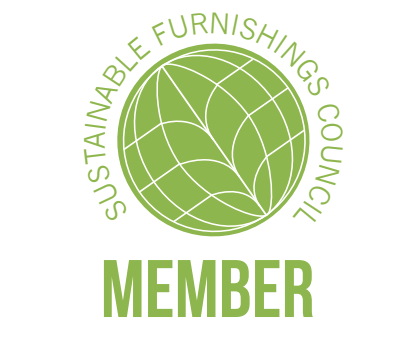Where does your furniture come from, and how is it made? Since 2006, the Sustainable Furnishings Council (SFC) has been asking this question of major designers, retailers, and manufacturers around the world. This nonprofit organization is a network of home furnishing companies devoted to educating and expanding the adoption of environmentally sustainable practices in the furniture industry.
While the average household is uninformed on the source and true quality of their furnishings, SFC makes it easy to find companies that have committed to “Eco-Action” plans as part of their production framework. These plans focus on improving carbon emissions, health, social equity, waste, water, and circularity within their companies and serve as an example for other industry leaders to follow. Through education and awareness, their stamp of membership is becoming a highly sought-after badge of approval.
Becoming a member of SFC starts with an application. Companies join by completing a Best Practices Agreement, including the Commitment Pledge and describing their ongoing efforts to reduce energy consumption, better manage their supply chain, and implement outreach and education initiatives. Additionally, they pay dues on a scale based on their sales or institutional budget.
As members, they gain access to a media tool kit that allows them to add the SFC branding to their websites, alerting customers of their commitment to sustainability. In combination with a network of diverse and like-minded companies, SFC also partners with environmental leaders such as National Wildlife Federation, Rainforest Alliance, and World Wildlife Fund. This alignment allows SFC and its members to have a guided, balanced, and informed perspective as they pursue their sustainability goals.
Branching off from SFC is their sister effort, the Sustainable Furnishings Education Fund (SFEF). The mission of SFEF is to educate furniture consumers, designers, and the residential furnishing industry on making sustainable choices and on the impact of their choices in materials, products, and services. SFC defines
sustainable furnishings as products that are made and distributed in ways that protect our planet. By purchasing through their network, consumers support companies that are working to reduce their environmental footprint, while gaining healthier products and design services in the process.
“Design decisions are important not only for the beauty, comfort and functionality of our homes, but also for the functionality of our future,” says Susan Inglis, Executive Director of the Sustainable Furnishings Council. “When we choose products that were made without harming the environment and that are not laden with harmful chemicals, we are supporting the possibility of sustaining a healthy future. That
is inner beauty and we at SFC are pleased to help every home find it.”
In the spirit of education, SFC also champions a popular program known as Green Leaders Certified Sustainability Training. The course is a total of six hours long and provides an overview of sustainability issues, applicable advice for growing an eco-friendly furnishing business, and helpful implementation plans. Program participants gain expert level sustainability knowledge and become recognized as a GREEN Accredited Professional. This outreach creates more leaders fighting for a better world, striving towards healthier interiors for both people and the planet.
How does the average consumer apply this new-found knowledge? There’s a resource for that, too. SFC has curated a “Quick Buying Guide” that demonstrates how we can ask the right questions when purchasing our furniture. Some of the themes include how
it’s made, where it comes from, and the ethos of the company.
Making an effort to preserve our natural resources and protect the environment should be at the top of the list when purchasing new furniture. Next time you eye a new piece of furniture, remember where it came from — it’s just as important as where it will go in your home.

Editor’s Note: Our cover story features Angelo Surmelis, who has been a member with the North Carolina Sustainability Council for more than ten years. He practices sustainability in designing as well making sure his furniture line is eco-friendly
— right down to the packaging and how it is shipped to customers.
Keep up with all of Green Living’s original content online and on social media.






